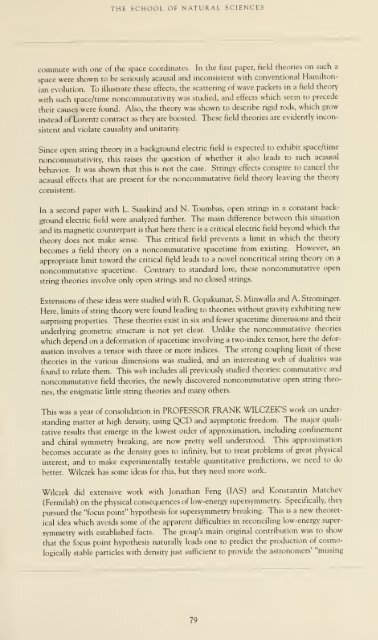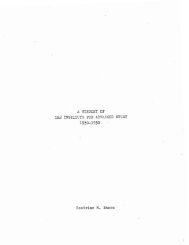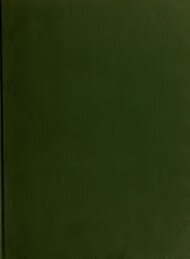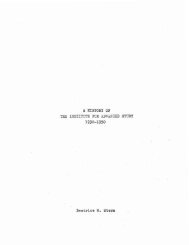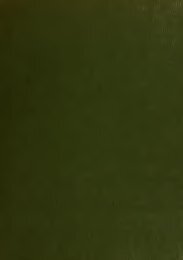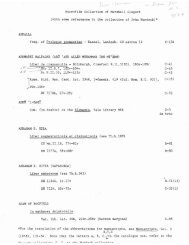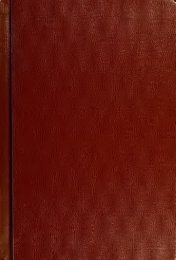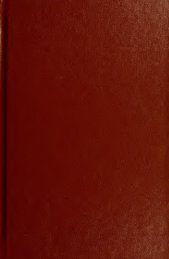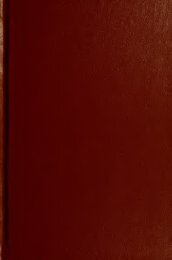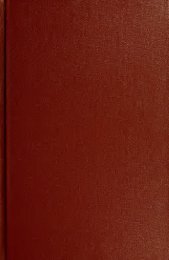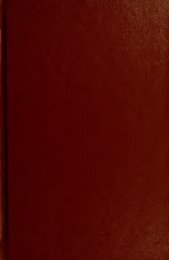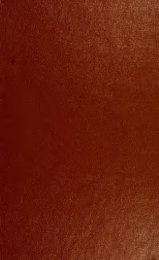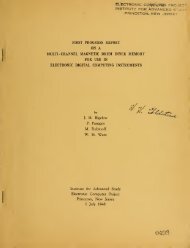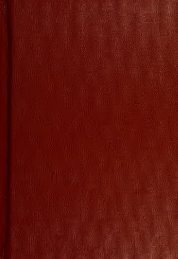Report for the academic year - Libraries - Institute for Advanced Study
Report for the academic year - Libraries - Institute for Advanced Study
Report for the academic year - Libraries - Institute for Advanced Study
You also want an ePaper? Increase the reach of your titles
YUMPU automatically turns print PDFs into web optimized ePapers that Google loves.
THE SCHOOL OF NATURAL SCIENCES<br />
commute with one of <strong>the</strong> space coordinates. In <strong>the</strong> first paper, field <strong>the</strong>ories on such a<br />
space were shown to be seriously acausal and inconsistent with conventional Hamilton-<br />
ian evolution. To illustrate <strong>the</strong>se effects, <strong>the</strong> scattering of wave packets in a field <strong>the</strong>ory<br />
with such space/time noncommutativity was studied, and effects which seem to precede<br />
<strong>the</strong>ir causes were found. Also, <strong>the</strong> <strong>the</strong>ory was shown to describe rigid rods, which grow<br />
instead of Lorentz contract as <strong>the</strong>y are boosted. These field <strong>the</strong>ories are evidently incon-<br />
sistent and violate causality and unitarity.<br />
Since open string <strong>the</strong>ory in a background electric field is expected to exhibit space/time<br />
noncommutativity, this raises <strong>the</strong> question of whe<strong>the</strong>r it also leads to such acausal<br />
behavior. It was shown that this is not <strong>the</strong> case. Stringy effects conspire to cancel <strong>the</strong><br />
acausal effects that are present <strong>for</strong> <strong>the</strong> noncommutative field <strong>the</strong>ory leaving <strong>the</strong> <strong>the</strong>ory<br />
consistent.<br />
In a second paper with L. Susskind and N. Toumbas, open strings in a constant back-<br />
ground electric field were analyzed fur<strong>the</strong>r. The main difference between this situation<br />
and its magnetic counterpart is that here <strong>the</strong>re is a critical electric field beyond which <strong>the</strong><br />
<strong>the</strong>ory does not make sense. This critical field prevents a limit in which <strong>the</strong> <strong>the</strong>ory<br />
becomes a field <strong>the</strong>ory on a noncommutative spacetime from existing. However, an<br />
appropriate limit toward <strong>the</strong> critical field leads to a novel noncritical string <strong>the</strong>ory on a<br />
noncommutative spacetime. Contrary to standard lore, <strong>the</strong>se noncommutative open<br />
string <strong>the</strong>ories involve only open strings and no closed strings.<br />
Extensions of <strong>the</strong>se ideas were studied with R. Gopakumar, S. Minwalla and A. Strominger.<br />
Here, limits of string <strong>the</strong>ory were found leading to <strong>the</strong>ories without gravity exhibiting new<br />
surprising properties. These <strong>the</strong>ories exist in six and fewer spacetime dimensions and <strong>the</strong>ir<br />
underlying geometric structure is not yet clear. Unlike <strong>the</strong> noncommutative <strong>the</strong>ories<br />
which depend on a de<strong>for</strong>mation of spacetime involving a two-index tensor, here <strong>the</strong> de<strong>for</strong>-<br />
mation involves a tensor with three or more indices. The strong coupling limit of <strong>the</strong>se<br />
<strong>the</strong>ories in <strong>the</strong> various dimensions was studied, and an interesting web of dualities was<br />
found to relate <strong>the</strong>m. This web includes all previously studied <strong>the</strong>ories: commutative and<br />
noncommutative field <strong>the</strong>ories, <strong>the</strong> newly discovered noncommutative open string <strong>the</strong>o-<br />
ries, <strong>the</strong> enigmatic little string <strong>the</strong>ories and many o<strong>the</strong>rs.<br />
This was a <strong>year</strong> of consolidation in PROFESSOR FRANK WILCZEK'S work on under-<br />
standing matter at high density, using QCD and asymptotic freedom. The major quali-<br />
tative results that emerge in <strong>the</strong> lowest order of approximation, including confinement<br />
and chiral symmetry breaking, are now pretty well understood. This approximation<br />
becomes accurate as <strong>the</strong> density goes to infinity, but to treat problems of great physical<br />
interest, and to make experimentally testable quantitative predictions, we need to do<br />
better. Wilczek has some ideas <strong>for</strong> this, but <strong>the</strong>y need more work.<br />
Wilczek did extensive work with Jonathan Feng (IAS) and Konstantin Matchev<br />
(Fermilab) on <strong>the</strong> physical consequences of low-energy supersymmetry. Specifically, <strong>the</strong>y<br />
pursued <strong>the</strong> "focus point" hypo<strong>the</strong>sis <strong>for</strong> supersymmetry breaking. This is a new <strong>the</strong>oret-<br />
ical idea which avoids some of <strong>the</strong> apparent difficulties in reconciling low-energy supersymmetry<br />
with established facts. The group's main original contribution was to show<br />
that <strong>the</strong> focus point hypo<strong>the</strong>sis naturally leads one to predict <strong>the</strong> production of cosmo-<br />
logically stable particles with density just sufficient to provide <strong>the</strong> astronomers' "missing<br />
79


